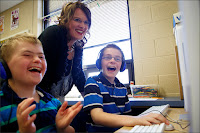Capitalizing on the Strengths of Students with Autism Spectrum Disorder

Oftentimes, the focus is on the deficits of a youngster with Asperger’s (AS) or High-Functioning Autism (HFA), which is common due to the child’s communication difficulties, learning disabilities, poor social skills, and/or tendency to experience meltdowns and tantrums. Years of corrective measures are often spent trying to fix the child’s deficits, rather than capitalizing on his assets. For example, if he has poor handwriting skills, hours are spent teaching that youngster using methods that didn't work in the first place, which often results in behavior problems. A youngster who is acting-out is a youngster who is frustrated over failure or perceived failure. If he can’t learn the way he is taught, he may as well be in a foreign language class. Behavior problems can get in the way of teaching to a youngster's assets. Discipline may reduce or eliminate problematic behavior temporarily, but does not provide stepping stones to more appropriate behavior. Usually
